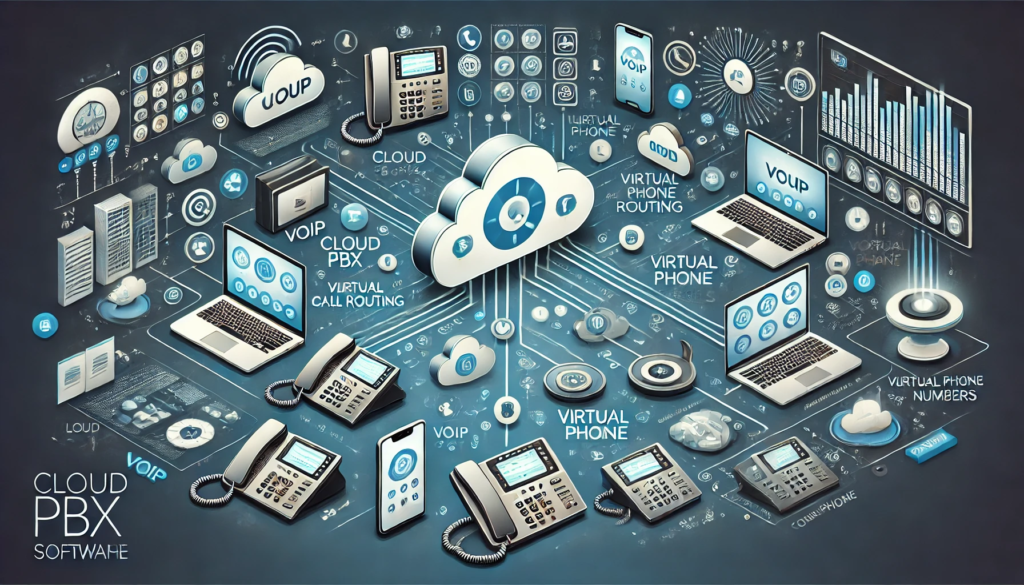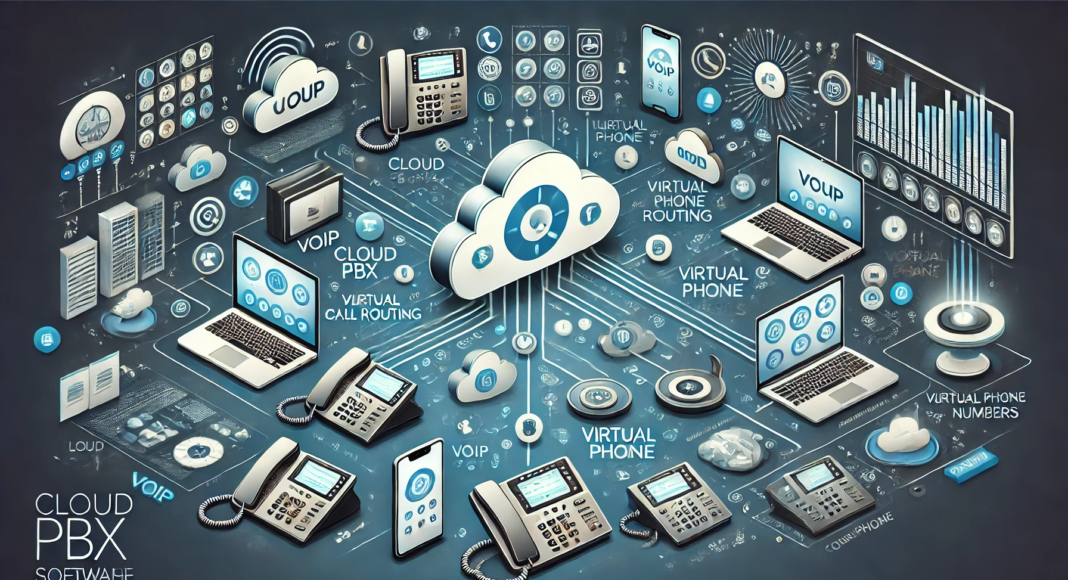Key Takeaways
- Cloud PBX software is an internet-based phone system that replaces traditional PBX, offering scalability, flexibility, and cost savings.
- It works via VoIP technology, enabling advanced call management, remote accessibility, and seamless integration with business tools.
- Businesses benefit from enhanced communication, reduced infrastructure costs, and AI-powered features for improved efficiency and customer service.
In today’s fast-paced digital world, businesses rely on efficient communication systems to stay connected with clients, partners, and employees.
Traditional phone systems, once the backbone of business communication, are increasingly being replaced by more advanced and cost-effective cloud-based solutions.
One such innovation is Cloud PBX (Private Branch Exchange) software, a modern telephony system that enables businesses to manage their phone operations over the internet rather than through conventional on-premise hardware.

As companies continue to embrace remote work, digital transformation, and cost-efficient IT solutions, cloud PBX has emerged as a critical tool for streamlining communication.
Unlike traditional PBX systems that require expensive infrastructure, dedicated phone lines, and ongoing maintenance, cloud PBX operates entirely online, eliminating the need for bulky equipment and offering greater flexibility. This makes it an ideal solution for startups, small businesses, and large enterprises alike.
But what exactly is Cloud PBX software, and how does it work?
How does it compare to traditional PBX systems, and what benefits does it bring to modern organizations?
Understanding these aspects is essential for businesses looking to enhance their communication strategies while reducing operational costs.
This guide provides a comprehensive overview of Cloud PBX software, explaining its functionality, key features, benefits, and challenges. Whether you are a business owner seeking an upgrade to your communication system or an IT professional exploring the latest trends in cloud-based telephony, this article will help you understand how Cloud PBX technology is transforming business communications in 2024 and beyond.
By the end of this guide, you will have a clear understanding of:
- What Cloud PBX software is and how it differs from traditional PBX systems.
- How Cloud PBX works, including its underlying technology and operational framework.
- The key features that make Cloud PBX a game-changer for business communication.
- The advantages and potential challenges of implementing a cloud-based phone system.
- How to choose the best Cloud PBX provider for your business needs.
With the demand for scalable, cost-effective, and flexible communication solutions on the rise, Cloud PBX is becoming an indispensable tool for organizations looking to optimize their operations. Let’s dive into the details and explore why Cloud PBX software is revolutionizing the way businesses communicate today.
Before we venture further into this article, we would like to share who we are and what we do.
About 9cv9
9cv9 is a business tech startup based in Singapore and Asia, with a strong presence all over the world.
With over nine years of startup and business experience, and being highly involved in connecting with thousands of companies and startups, the 9cv9 team has listed some important learning points in this overview of What is Cloud PBX Software and How It Works.
If your company needs recruitment and headhunting services to hire top-quality employees, you can use 9cv9 headhunting and recruitment services to hire top talents and candidates. Find out more here, or send over an email to [email protected].
Or just post 1 free job posting here at 9cv9 Hiring Portal in under 10 minutes.
What is Cloud PBX Software and How It Works
- What is Cloud PBX Software?
- How Cloud PBX Software Works
- Key Features of Cloud PBX Software
- Benefits of Using Cloud PBX Software
- Challenges and Considerations When Adopting Cloud PBX
- How to Choose the Right Cloud PBX Software for Your Business
- Future Trends in Cloud PBX Technology
1. What is Cloud PBX Software?
Cloud PBX (Private Branch Exchange) software is a modern, internet-based phone system that allows businesses to manage their communication services without the need for traditional on-premise hardware. Unlike conventional PBX systems that rely on physical infrastructure and dedicated phone lines, Cloud PBX operates over the internet using Voice over Internet Protocol (VoIP) technology, offering greater flexibility, scalability, and cost efficiency.
How Cloud PBX Differs from Traditional PBX Systems
1. Traditional PBX Systems
- Hardware-based – Requires physical servers, phone lines, and on-premise infrastructure.
- High setup and maintenance costs – Expensive to install, maintain, and upgrade.
- Limited scalability – Adding new phone lines often requires additional hardware.
- Restricted accessibility – Users must be physically present in the office to use the system.
- Complicated setup and configuration – Requires specialized IT personnel for operation and troubleshooting.
2. Cloud PBX Systems
- Internet-based – Operates over the cloud, eliminating the need for physical infrastructure.
- Cost-efficient – Reduces hardware and maintenance costs, as everything is managed by a third-party provider.
- Highly scalable – Businesses can add or remove users with minimal effort.
- Remote-friendly – Employees can access the phone system from anywhere with an internet connection.
- Easy to set up and manage – Most providers offer a user-friendly dashboard for configuration and monitoring.
How Cloud PBX Works
Cloud PBX software functions by routing calls through the internet rather than traditional copper-wire telephone lines. Here’s how it works:
1. Call Routing via VoIP Technology
- Cloud PBX converts voice signals into digital packets that travel over the internet.
- These packets are then transmitted to the recipient’s device, whether it is a desk phone, mobile phone, or computer.
- Once received, the digital packets are converted back into audio signals, enabling clear, real-time communication.
2. Hosted in the Cloud
- Unlike traditional PBX, which requires on-premise servers, Cloud PBX is hosted on secure cloud serversmanaged by a third-party provider.
- Businesses rent access to the service rather than investing in expensive hardware.
- This ensures automatic software updates, security enhancements, and minimal downtime.
3. Seamless Integration with Other Business Tools
- Cloud PBX integrates with Customer Relationship Management (CRM) platforms, helpdesk software, and productivity tools to improve workflow efficiency.
- Examples:
- Sales teams can connect Cloud PBX with CRM tools like Salesforce or HubSpot to track customer interactions.
- Customer support teams can integrate with Zendesk or Freshdesk for better ticket management.
Key Components of Cloud PBX Software
1. VoIP (Voice over Internet Protocol) Technology
- Converts voice signals into digital packets for transmission over the internet.
- Ensures cost-effective, high-quality calls without relying on traditional landlines.
2. SIP Trunking (Session Initiation Protocol)
- Establishes connections between the Cloud PBX system and the Public Switched Telephone Network (PSTN).
- Allows businesses to make and receive calls from traditional phone numbers.
3. Auto-Attendant and IVR (Interactive Voice Response)
- An automated system that guides callers through menu options without needing a live receptionist.
- Example:
- A company may set up an IVR menu with options like:
- Press 1 for Sales
- Press 2 for Customer Support
- Press 3 for Billing
- A company may set up an IVR menu with options like:
4. Call Management and Routing
- Features include call forwarding, call transfer, voicemail-to-email, and call queuing.
- Example:
- A remote employee can receive calls on their smartphone, even if the main office is located in another country.
5. Call Analytics and Reporting
- Businesses can track call duration, peak call times, customer satisfaction, and missed calls.
- Example:
- A customer service team can monitor response times and adjust staffing levels accordingly.
Examples of Cloud PBX Software Providers
There are many Cloud PBX service providers, each offering unique features and pricing plans. Some of the most well-known providers include:
1. RingCentral
- Best for: Large enterprises needing a unified communication platform.
- Key features: AI-powered call insights, CRM integrations, HD video conferencing.
2. 8×8
- Best for: Businesses needing global communication capabilities.
- Key features: International calling, call analytics, contact center solutions.
3. Grasshopper
- Best for: Small businesses and startups looking for a virtual phone system.
- Key features: Voicemail transcription, mobile and desktop apps, business texting.
4. Nextiva
- Best for: Companies needing advanced call routing and CRM integrations.
- Key features: Call pop, auto-attendant, advanced analytics.
5. Vonage Business Communications
- Best for: Businesses requiring flexible API integrations.
- Key features: AI-powered chatbots, SMS and video calling, call recording.
Why Businesses Are Adopting Cloud PBX
Many companies are moving away from traditional PBX systems in favor of Cloud PBX because of its numerous advantages:
- Cost Savings: Eliminates the need for expensive on-premise hardware and reduces maintenance costs.
- Scalability: Businesses can easily add or remove users based on demand.
- Flexibility: Employees can make and receive calls from anywhere, promoting remote work and global collaboration.
- Reliability: Cloud PBX providers offer 99.9% uptime guarantees with built-in redundancy to prevent service disruptions.
- Enhanced Security: Advanced encryption protocols and compliance measures ensure data protection.
Conclusion
Cloud PBX software is revolutionizing business communication by offering a cost-effective, scalable, and flexible alternative to traditional PBX systems. With internet-based calling, seamless integrations, and advanced call management features, Cloud PBX is becoming an essential tool for businesses of all sizes. As remote work and digital transformation continue to evolve, Cloud PBX adoption will only grow, making it a smart investment for forward-thinking organizations.
2. How Cloud PBX Software Works
Cloud PBX software operates using internet-based VoIP technology, allowing businesses to manage and route phone calls without relying on traditional telephone lines. Unlike conventional PBX systems that require on-premise hardware, Cloud PBX is hosted by a third-party provider, ensuring seamless connectivity, flexibility, and scalability.
Below is a detailed breakdown of how Cloud PBX software works, including its key components, call routing process, and real-world applications.
1. The Role of VoIP in Cloud PBX
1.1 What is VoIP (Voice over Internet Protocol)?
- VoIP is the foundation of Cloud PBX systems, enabling voice communication over the internet instead of traditional phone networks.
- It converts analog voice signals into digital data packets and transmits them over an IP network.
- VoIP ensures cost-effective, high-quality voice calls with greater flexibility.
1.2 How VoIP Enables Cloud PBX Functionality
- When a user makes a call, the VoIP system:
- Converts the caller’s voice into digital packets.
- Sends these packets through the internet to the recipient’s device.
- The recipient’s device reassembles the packets into a clear voice signal.
- This process allows businesses to handle multiple calls simultaneously without needing dedicated phone lines.
1.3 Example of VoIP in Action
- A remote employee using a Cloud PBX system can make calls from a company-issued VoIP phone, a mobile app, or a desktop softphone.
- The call is routed through the cloud, allowing them to communicate with customers or colleagues from anywhere.
2. Call Routing and Management in Cloud PBX
2.1 How Cloud PBX Handles Incoming Calls
- When a customer calls a business number, the Cloud PBX system:
- Identifies the caller’s number and applies pre-configured call rules.
- Uses Interactive Voice Response (IVR) or Auto-Attendant to guide the caller.
- Directs the call to the appropriate department or agent based on availability.
2.2 Key Features in Call Routing
- Automatic Call Distribution (ACD) – Routes calls to agents based on availability and skillset.
- Find Me/Follow Me – Forwards calls to multiple devices (e.g., desk phone, mobile phone, softphone).
- Call Forwarding – Redirects calls to another number or voicemail if unavailable.
- Ring Groups – Calls ring multiple extensions simultaneously or in a specific order.
2.3 Example of Call Routing
- A customer calls a retail business and hears:
- “Press 1 for Sales, Press 2 for Customer Support.”
- If the customer presses 1, the system checks for available sales agents and routes the call accordingly.
- If no agents are available, the call queues until an agent is free or redirects to voicemail.
3. Cloud Hosting and Infrastructure
3.1 How Cloud PBX is Hosted
- Cloud PBX providers host their infrastructure in secure data centers rather than on-premise servers.
- The system operates on a distributed network, ensuring redundancy and uptime reliability.
- Businesses access the system via a web-based dashboard or mobile app.
3.2 Benefits of Cloud Hosting
- No Physical Hardware Needed – Reduces IT maintenance and operational costs.
- Scalability – Businesses can add or remove users easily without infrastructure changes.
- Automatic Updates – Software enhancements and security patches are handled by the provider.
3.3 Example of Cloud Hosting in Action
- A startup with five employees subscribes to a Cloud PBX service.
- As the company expands, new employees can be added instantly through the provider’s online portal.
- The system updates automatically without requiring IT staff to configure new servers or phone lines.
4. Integration with Business Applications
4.1 How Cloud PBX Integrates with Other Tools
- Cloud PBX systems integrate seamlessly with CRM platforms, helpdesk software, and team collaboration tools.
- APIs and built-in connectors allow data synchronization between applications.
4.2 Common Business Integrations
- CRM Integration – Syncs call logs and customer details with platforms like Salesforce or HubSpot.
- Helpdesk Integration – Links with Zendesk or Freshdesk to manage support tickets more efficiently.
- Collaboration Tools – Connects with platforms like Slack or Microsoft Teams for unified communications.
4.3 Example of CRM Integration
- A salesperson receives a call from a potential client.
- Cloud PBX automatically pulls up the client’s history from the CRM and displays relevant information.
- The agent can log call details directly into the CRM, reducing manual data entry.
5. Security and Reliability in Cloud PBX
5.1 Security Features of Cloud PBX
- End-to-End Encryption – Protects calls and messages from unauthorized access.
- Multi-Factor Authentication (MFA) – Ensures secure login for employees.
- Fraud Detection Systems – Monitors for unusual call patterns to prevent toll fraud.
5.2 Reliability and Disaster Recovery
- Cloud PBX providers operate redundant data centers to prevent service outages.
- Calls can be rerouted to mobile devices in case of internet disruptions.
5.3 Example of Reliability in Action
- A financial services firm experiences a power outage at their main office.
- Employees continue making and receiving calls using mobile apps, ensuring uninterrupted client communication.
6. User-Friendly Management and Customization
6.1 Web-Based Management Portals
- Businesses can configure Cloud PBX settings via intuitive web dashboards.
- Administrators can manage:
- Call routing rules
- User permissions
- Voicemail settings
- Reporting and analytics
6.2 Customization Options
- Custom Greetings & Hold Music – Personalizes the caller experience.
- Advanced Call Analytics – Provides insights into call patterns and agent performance.
6.3 Example of Customization
- A tech support center sets up a custom IVR that directs callers based on issue type (hardware vs. software).
- The system prioritizes urgent cases, improving response times.
Conclusion
Cloud PBX software streamlines business communication by leveraging VoIP technology, cloud hosting, and intelligent call management. It enables seamless call routing, integrates with key business applications, and offers enterprise-grade security. With features like auto-attendants, mobile flexibility, and real-time analytics, Cloud PBX is an ideal solution for businesses looking to enhance efficiency and reduce operational costs.
As remote work and digital transformation continue to evolve, Cloud PBX adoption will grow, making it a valuable investment for companies seeking scalable, reliable, and cost-effective communication solutions.
3. Key Features of Cloud PBX Software
Cloud PBX software is packed with advanced communication features that enhance business efficiency, flexibility, and cost savings. Unlike traditional PBX systems, Cloud PBX provides a scalable, cloud-based infrastructure that enables organizations to handle calls, messages, and customer interactions seamlessly.
Below is a detailed breakdown of the key features of Cloud PBX software, highlighting how each feature contributes to enhanced communication and productivity.
1. Virtual Auto-Attendant & IVR (Interactive Voice Response)
1.1 What is a Virtual Auto-Attendant?
- An automated receptionist that answers incoming calls and directs callers based on predefined options.
- Ensures efficient call routing without requiring a human operator.
- Provides a professional brand image by greeting customers with a custom message.
1.2 How IVR Enhances Call Handling
- Allows customers to navigate through a menu-based system using voice commands or keypad inputs.
- Routes callers to the correct department, reducing hold times and misrouted calls.
- Supports multi-level IVR, allowing more complex call flows (e.g., Press 1 for Sales, then Press 2 for Enterprise Clients).
1.3 Example of IVR in Action
- A banking customer calls a Cloud PBX-powered hotline and hears:
- “Press 1 for Account Balance, Press 2 for Loan Services, Press 3 for Customer Support.”
- The system automatically routes the call to the relevant department without requiring human intervention.
2. Call Forwarding and Find Me/Follow Me
2.1 What is Call Forwarding?
- Redirects incoming calls to another phone number, ensuring no missed calls.
- Can be set to forward calls to different locations based on time or availability.
2.2 Find Me/Follow Me Feature
- Enables employees to receive calls on multiple devices (desk phone, mobile, softphone).
- Calls can ring all devices simultaneously or follow a specific order (e.g., ring desk phone first, then mobile if unanswered).
2.3 Example of Find Me/Follow Me
- A sales executive is on the move.
- Calls to their office phone automatically ring their mobile phone or laptop softphone if they are not at their desk.
- Ensures seamless customer communication without requiring clients to dial multiple numbers.
3. Voicemail-to-Email and Voicemail Transcription
3.1 How Voicemail-to-Email Works
- Converts voicemail messages into audio files and sends them to the recipient’s email.
- Allows employees to access voicemail messages from anywhere.
3.2 Voicemail Transcription
- Transcribes voicemail messages into text format and delivers them via email or SMS.
- Enables users to read messages quickly without listening to audio recordings.
3.3 Example of Voicemail Transcription
- A busy CEO receives a voicemail but is in a meeting.
- Instead of listening to the message, they read the voicemail transcript in their email inbox, allowing for a faster response.
4. Call Recording & Call Analytics
4.1 What is Call Recording?
- Records incoming and outgoing calls for quality assurance and compliance.
- Stores recordings in the cloud for easy access and retrieval.
- Helps in training employees by reviewing past calls.
4.2 Call Analytics and Reporting
- Provides detailed insights into call volume, duration, and response times.
- Tracks missed calls, peak call hours, and agent performance.
- Helps businesses optimize customer support and sales strategies.
4.3 Example of Call Analytics Usage
- A customer service team reviews call recordings to assess agent performance and customer satisfaction levels.
- Managers identify trends in call duration and resolution times, helping to refine support processes.
5. Multi-Device Compatibility & Mobile App Support
5.1 Device Flexibility
- Cloud PBX can be accessed from:
- Desk phones (IP phones)
- Smartphones (via mobile apps)
- Laptops and desktops (softphones and web portals)
5.2 Mobile App Integration
- Allows employees to make and receive business calls using a dedicated VoIP app.
- Enables remote teams to stay connected without being tied to an office phone system.
- Supports instant messaging, call forwarding, and video conferencing on mobile.
5.3 Example of Mobile App Usage
- A remote worker uses a Cloud PBX mobile app to take client calls while traveling.
- The call appears as coming from the company’s business number, maintaining professionalism.
6. Call Conferencing and Collaboration Tools
6.1 Built-in Call Conferencing
- Supports multi-party calls for team meetings and client discussions.
- Eliminates the need for third-party conferencing services.
- Includes mute, hold, and participant management features.
6.2 Integration with Collaboration Tools
- Cloud PBX integrates with tools like:
- Microsoft Teams, Slack, Zoom, Google Meet
- Project management platforms like Trello and Asana
6.3 Example of Call Conferencing
- A marketing team in different locations joins a conference call via Cloud PBX to discuss a new campaign.
- Team members can collaborate in real-time, reducing email back-and-forth.
7. Security and Compliance Features
7.1 Data Encryption & Secure Communication
- Encrypts voice calls and messages to prevent unauthorized access.
- Ensures compliance with data protection laws (e.g., GDPR, HIPAA).
7.2 Fraud Detection & Prevention
- Monitors call traffic for suspicious activity (e.g., toll fraud, unauthorized international calls).
- Blocks high-risk numbers and alerts administrators of potential threats.
7.3 Example of Security in Action
- A law firm using Cloud PBX ensures that all client calls are encrypted, preventing data breaches.
- The system detects an unusual number of international calls, triggering a security alert.
8. Scalability and Customization
8.1 Easily Add or Remove Users
- Businesses can scale their phone system up or down based on team size.
- New users can be added instantly without hardware installation.
8.2 Custom Call Flows & Routing
- Businesses can set custom call routing rules based on:
- Business hours (e.g., after-hours calls go to voicemail)
- Caller location (e.g., international callers redirected to global support teams)
8.3 Example of Scalability
- A growing e-commerce company expands its team and adds 10 new agents to its Cloud PBX system in minutes.
- No additional infrastructure is needed, making scaling cost-effective and hassle-free.
Conclusion
Cloud PBX software offers a robust set of features that improve business communication, flexibility, and customer engagement. From automated call handling and voicemail transcription to mobile app support and advanced security, Cloud PBX provides businesses with the tools they need to enhance efficiency and reduce operational costs.
By leveraging scalable and customizable solutions, organizations can future-proof their communication systems while ensuring seamless collaboration and superior customer service.
4. Benefits of Using Cloud PBX Software
Cloud PBX software offers a wide range of business benefits, making it an essential tool for modern organizations looking to improve communication, efficiency, and scalability. Unlike traditional PBX systems that rely on expensive hardware and fixed phone lines, Cloud PBX leverages the internet to deliver flexible, cost-effective, and feature-rich communication solutions.
This section explores the major advantages of Cloud PBX software, highlighting how businesses can enhance productivity, reduce costs, and improve customer experiences.
1. Cost Savings and Reduced Infrastructure Expenses
1.1 Lower Installation and Maintenance Costs
- Traditional PBX systems require on-premise hardware, dedicated phone lines, and complex wiring.
- Cloud PBX operates entirely over the internet, eliminating the need for expensive equipment and infrastructure.
- Businesses save on setup, maintenance, and upgrade costs.
1.2 Pay-as-You-Go Pricing Model
- Most Cloud PBX providers offer subscription-based pricing with flexible plans.
- Companies pay only for the features and users they need, avoiding large upfront investments.
- Ideal for startups and small businesses looking for cost-efficient communication solutions.
1.3 Example: Reducing Communication Costs for a Remote Team
- A global e-commerce business with a remote team shifts from a traditional PBX to a Cloud PBX solution.
- By eliminating landline costs and long-distance call charges, the company saves 40% on annual communication expenses.
2. Scalability and Flexibility for Growing Businesses
2.1 Easily Add or Remove Users
- Businesses can instantly scale their phone system based on employee needs.
- No need for additional hardware or physical installations.
- Perfect for fast-growing companies and seasonal businesses.
2.2 Geographic Flexibility
- Employees can make and receive calls from anywhere, using mobile apps, softphones, or desk phones.
- Companies can establish a global presence with virtual phone numbers for different regions.
2.3 Example: A Growing Startup Expands Without Extra Costs
- A tech startup with a team of 10 employees expands to 50 employees within a year.
- Instead of installing physical phone lines, the company adds new users in minutes through Cloud PBX, avoiding infrastructure expansion costs.
3. Enhanced Mobility and Remote Work Support
3.1 Work From Anywhere with Cloud PBX
- Employees can connect to the business phone system remotely via:
- Mobile apps
- Desktop softphones
- Web-based portals
- Perfect for remote teams, freelancers, and field workers.
3.2 Calls Follow Employees Across Devices
- Features like Find Me/Follow Me allow calls to ring multiple devices before going to voicemail.
- Ensures seamless communication, even when employees are away from their desks.
3.3 Example: A Remote Sales Team Staying Connected
- A real estate company has sales agents working in different locations.
- With Cloud PBX mobile apps, agents can answer calls, join conference calls, and check voicemails from their smartphones, ensuring constant availability.
4. Improved Call Management and Productivity
4.1 Automated Call Routing and IVR
- Cloud PBX includes auto-attendants and IVR (Interactive Voice Response) to handle and route calls efficiently.
- Reduces manual call transfers and ensures callers reach the right department quickly.
4.2 Voicemail-to-Email and Call Transcription
- Converts voicemail messages into text or email notifications, making them easier to access and manage.
- Employees no longer have to dial in to check voicemails manually.
4.3 Call Recording for Quality Control
- Records incoming and outgoing calls for performance monitoring and compliance.
- Useful for customer service training and dispute resolution.
4.4 Example: Enhancing Customer Support Efficiency
- A customer service center implements IVR and auto-routing through Cloud PBX.
- As a result, call wait times decrease by 30%, and customers get connected to the right agents without delays.
5. Business Continuity and Disaster Recovery
5.1 Cloud-Based Infrastructure Ensures Reliability
- Unlike traditional phone systems that rely on local hardware, Cloud PBX operates on redundant cloud servers.
- Ensures continuous service availability, even during internet outages or system failures.
5.2 Automatic Failover and Backup Solutions
- Calls can be rerouted to mobile phones or backup locations in case of technical issues.
- Protects businesses from disruptions due to natural disasters, cyberattacks, or power failures.
5.3 Example: A Law Firm Maintains Communication During a Power Outage
- A law firm experiences a power failure in its main office.
- Thanks to Cloud PBX, calls automatically reroute to mobile phones, ensuring no missed client inquiries.
6. Increased Security and Compliance
6.1 End-to-End Encryption for Secure Communication
- Cloud PBX providers use AES encryption and secure VoIP protocols to protect calls.
- Prevents unauthorized eavesdropping and data breaches.
6.2 Compliance with Industry Regulations
- Meets regulatory standards like HIPAA, GDPR, and PCI DSS for data privacy.
- Essential for businesses handling sensitive customer information (e.g., healthcare, finance, legal sectors).
6.3 Example: Securing Client Calls for a Healthcare Provider
- A telehealth provider uses Cloud PBX with HIPAA-compliant encryption to protect patient consultations.
- Ensures that patient data remains confidential and secure.
7. Seamless Integration with Business Tools
7.1 CRM and Helpdesk Integration
- Connects with CRM platforms like Salesforce, HubSpot, and Zoho for better customer interactions.
- Automatically logs call details and syncs data with customer records.
7.2 Integration with Collaboration Tools
- Works with apps like Microsoft Teams, Slack, and Zoom for seamless team communication.
- Supports video conferencing and team messaging alongside voice calls.
7.3 Example: Boosting Sales Team Efficiency
- A sales team integrates Cloud PBX with HubSpot CRM, allowing automatic call logging and follow-up reminders.
- Improves lead management and sales tracking.
8. Local and Global Reach with Virtual Phone Numbers
8.1 Establish Local Presence with Virtual Numbers
- Businesses can acquire local phone numbers in different regions without needing physical offices.
- Improves customer trust and engagement.
8.2 Toll-Free and International Number Support
- Provides toll-free numbers for customer support.
- Reduces barriers for international clients, enhancing global business reach.
8.3 Example: Expanding Customer Support to New Markets
- A software company expands to the UK and acquires a UK virtual number, allowing local customers to call without international charges.
Conclusion
Cloud PBX software delivers unmatched benefits in terms of cost savings, scalability, remote work flexibility, security, and customer experience. With advanced call management features, seamless integrations, and disaster recovery solutions, businesses can ensure efficient and uninterrupted communication.
As companies continue to embrace digital transformation, Cloud PBX remains an essential tool for organizations looking to enhance collaboration, improve customer service, and future-proof their communication infrastructure.
5. Challenges and Considerations When Adopting Cloud PBX
While Cloud PBX software offers numerous benefits such as cost savings, scalability, and remote work flexibility, businesses must be aware of certain challenges and key considerations before implementation. Adopting Cloud PBX requires careful planning, technical readiness, and an understanding of potential obstacles that can impact its efficiency and reliability.
This section explores the main challenges and considerations businesses should evaluate to ensure a smooth and successful transition to Cloud PBX.
1. Dependence on Internet Connectivity
1.1 Cloud PBX Requires a Stable Internet Connection
- Unlike traditional phone systems that rely on landlines, Cloud PBX operates over the internet.
- If a company’s internet connection is unstable, slow, or experiences frequent outages, it can lead to dropped calls, poor call quality, and service disruptions.
1.2 Bandwidth and Network Capacity Issues
- High-quality voice calls require sufficient bandwidth to avoid latency and jitter.
- If the company’s network is overloaded with data traffic, Cloud PBX performance may decline.
- Businesses need to assess their network infrastructure before switching.
1.3 Example: Poor Connectivity Affecting Customer Service
- A small e-commerce business adopts Cloud PBX but experiences frequent call drops due to an unreliable internet connection.
- This leads to missed customer inquiries and lost sales, forcing the company to upgrade to a higher-speed internet provider.
2. Voice Quality and Latency Issues
2.1 Factors Affecting Call Quality
- Jitter, packet loss, and latency can affect the clarity of VoIP calls.
- Businesses in locations with high network congestion or outdated infrastructure may experience delays.
2.2 Quality of Service (QoS) Configuration
- Companies need to prioritize voice traffic over other data streams to maintain quality.
- QoS settings on routers can help ensure smooth call experiences.
2.3 Example: Call Latency Impacting a Remote Sales Team
- A remote sales team experiences delays in conversations with clients due to high network latency.
- They implement VoIP-optimized routers and dedicated internet bandwidth to resolve the issue.
3. Security Risks and Data Privacy Concerns
3.1 VoIP Security Threats
- Cloud PBX systems are vulnerable to cyberattacks such as hacking, phishing, and VoIP fraud.
- Attackers can exploit weak passwords or unencrypted connections to intercept calls.
3.2 Compliance with Industry Regulations
- Companies in healthcare, finance, or legal sectors must ensure Cloud PBX meets GDPR, HIPAA, or PCI DSS compliance.
- Data privacy policies must be reviewed to prevent leakage of sensitive customer data.
3.3 Example: Preventing VoIP Fraud in a Financial Firm
- A financial services company using Cloud PBX faced an attack where hackers made unauthorized international calls, increasing telecom costs.
- They implemented two-factor authentication and IP whitelisting to prevent fraud.
4. Integration Challenges with Existing Business Tools
4.1 Compatibility with CRM, Helpdesk, and Collaboration Software
- Cloud PBX should seamlessly integrate with tools like Salesforce, HubSpot, Microsoft Teams, and Slack.
- Some PBX solutions may have limited integrations, requiring custom development.
4.2 API and Customization Limitations
- Not all Cloud PBX providers offer open APIs for extensive customizations.
- Businesses needing advanced call automation may face technical barriers.
4.3 Example: CRM Integration Challenges in a Support Center
- A customer support center adopts Cloud PBX but struggles to sync call logs with their CRM.
- They switch to a provider offering native integration with their CRM software.
5. Vendor Reliability and Service Uptime
5.1 Evaluating Cloud PBX Provider Reliability
- Service providers should offer 99.99% uptime with redundant data centers.
- Businesses must review SLA (Service Level Agreement) guarantees before adoption.
5.2 Risk of Vendor Lock-in
- Some Cloud PBX vendors restrict portability, making it hard to switch providers.
- Businesses should choose providers with flexible contract terms and data migration options.
5.3 Example: Downtime Impacting Business Operations
- A logistics company experiences three hours of Cloud PBX downtime, disrupting client communications.
- They migrate to a provider offering 24/7 support and a strong SLA guarantee.
6. Training and User Adoption Challenges
6.1 Employee Learning Curve
- Employees unfamiliar with VoIP technology and cloud-based phone systems may face challenges in adoption.
- Businesses need to invest in training and onboarding.
6.2 Resistance to Change
- Employees accustomed to traditional desk phones may resist adopting Cloud PBX mobile or softphone applications.
- Clear communication on benefits and ease of use is essential.
6.3 Example: Training Remote Employees for Cloud PBX Usage
- A consulting firm with a remote workforce struggled with employees not using Cloud PBX features effectively.
- They implemented virtual training sessions and user guides to boost adoption.
7. Compliance with Local Telecommunication Regulations
7.1 Country-Specific VoIP Restrictions
- Some countries have strict regulations on VoIP services (e.g., UAE, China).
- Businesses operating globally must ensure Cloud PBX complies with local laws.
7.2 Licensing and Emergency Call Requirements
- Some regions require emergency call (E911) registration for Cloud PBX.
- Failure to comply may lead to fines or service restrictions.
7.3 Example: VoIP Restrictions Impacting International Expansion
- A US-based company expanding to the UAE discovered VoIP restrictions preventing Cloud PBX use.
- They partnered with local telecom providers to comply with regulations.
8. Backup and Disaster Recovery Considerations
8.1 Preparing for Internet Outages and Power Failures
- Businesses need a failover plan, such as automatic call forwarding to mobile numbers.
- Investing in backup internet solutions (e.g., 4G LTE or secondary ISPs) is recommended.
8.2 Data Loss Prevention Strategies
- Cloud PBX providers should offer call logs and voicemail backups to prevent data loss.
- Businesses should confirm disaster recovery options before selecting a provider.
8.3 Example: Cloud PBX Failover Plan for an IT Firm
- A tech company implemented auto-routing to backup phone numbers during internet failures.
- This ensured zero disruptions for customer support operations.
Conclusion
While Cloud PBX software brings modern communication advantages, businesses must carefully evaluate potential challenges before adoption. Internet reliability, security risks, compliance requirements, vendor reliability, and integration issues can impact performance.
To ensure successful deployment, businesses should:
- Conduct network assessments and ensure strong internet bandwidth.
- Choose a reliable Cloud PBX vendor with high uptime guarantees.
- Train employees and streamline the adoption process.
- Plan for failover solutions and regulatory compliance.
By addressing these challenges proactively, companies can leverage the full potential of Cloud PBX while minimizing risks.
6. How to Choose the Right Cloud PBX Software for Your Business
Selecting the right Cloud PBX software is a critical decision for businesses seeking to improve communication, reduce costs, and enhance operational efficiency. With numerous providers offering a wide range of features, it is essential to evaluate various factors to ensure the chosen solution aligns with your business needs, budget, and technical infrastructure.
This guide outlines the key considerations businesses should assess when selecting Cloud PBX software.
1. Assess Your Business Communication Needs
1.1 Identify the Number of Users and Locations
- Determine how many employees will use the system to choose an appropriate plan.
- Consider whether the PBX system will serve a single office, multiple locations, or remote teams.
1.2 Analyze Call Volume and Usage Patterns
- Assess expected call traffic to determine if the provider can handle peak usage.
- If your business has high inbound and outbound call volumes, look for a solution with unlimited calling options.
1.3 Example: Choosing a Scalable Cloud PBX for a Growing Business
- A small marketing agency with 10 employees initially selects a Cloud PBX plan with limited extensions.
- As the business expands, they switch to a scalable plan supporting up to 100 users to accommodate growth.
2. Evaluate Core Features and Functionality
2.1 Essential Cloud PBX Features
- Auto-attendant: Automatically routes calls to the appropriate department.
- Call forwarding and routing: Ensures calls are directed to the right personnel.
- Voicemail-to-email: Converts voicemail messages into email transcriptions.
- Call recording: Useful for quality assurance, training, and compliance.
2.2 Advanced Features for Business Efficiency
- Unified Communications (UCaaS): Integrates Cloud PBX with video conferencing, instant messaging, and file sharing.
- Interactive Voice Response (IVR): Enhances call automation for customer inquiries.
- Call analytics and reporting: Provides insights into call volume, response times, and agent performance.
2.3 Example: A Tech Startup Needing Advanced Call Routing
- A tech support company with a global customer base opts for a Cloud PBX system with AI-powered IVR to improve call handling and reduce wait times.
3. Ensure Reliability and Call Quality
3.1 Uptime and Service Level Agreement (SLA)
- Look for 99.99% uptime guarantees to minimize service disruptions.
- Choose providers with redundant data centers and failover mechanisms for reliability.
3.2 Call Quality and Network Optimization
- Ensure the provider uses high-definition (HD) voice technology to enhance clarity.
- Consider Quality of Service (QoS) settings to prioritize VoIP traffic over other internet activities.
3.3 Example: A Retail Business Experiencing Call Quality Issues
- A nationwide retail chain using Cloud PBX faced call drops due to network congestion.
- They switched to a provider offering dedicated VoIP bandwidth and optimized QoS settings for clear communication.
4. Check Integration Capabilities
4.1 Compatibility with CRM and Business Software
- Ensure the Cloud PBX integrates with CRM platforms like Salesforce, HubSpot, or Zoho CRM.
- Look for compatibility with collaboration tools such as Slack, Microsoft Teams, and Google Workspace.
4.2 Open API and Customization Options
- Some businesses require custom workflows and automation that an open API can provide.
- Verify whether the provider supports third-party integrations and API access.
4.3 Example: A Sales Team Automating Call Logs with CRM
- A real estate firm integrates Cloud PBX with Salesforce, enabling automatic call logs and lead tracking to improve client follow-ups.
5. Security and Compliance Considerations
5.1 Encryption and Data Protection
- Choose a provider that offers end-to-end encryption for voice and messaging data.
- Verify secure authentication mechanisms like multi-factor authentication (MFA).
5.2 Compliance with Industry Standards
- Businesses handling sensitive data should ensure Cloud PBX is compliant with:
- HIPAA for healthcare organizations.
- PCI DSS for businesses handling payment transactions.
- GDPR for companies dealing with EU customer data.
5.3 Example: A Healthcare Provider Adopting HIPAA-Compliant PBX
- A telemedicine service selects a Cloud PBX provider with HIPAA compliance to secure patient communication and prevent data breaches.
6. Scalability and Future-Proofing
6.1 Flexible Plans for Business Growth
- Choose a provider that allows easy scaling of users, extensions, and features.
- Consider whether you can upgrade without incurring high additional costs.
6.2 Support for Remote and Hybrid Workforces
- Ensure the system supports mobile apps, softphones, and remote access.
- Look for features like call forwarding to personal devices and web-based admin controls.
6.3 Example: A Multinational Company Expanding to New Regions
- A software development firm expands into Asia and Europe and selects a Cloud PBX provider with global data centers to maintain consistent call quality.
7. Customer Support and Technical Assistance
7.1 Availability of 24/7 Support
- Opt for providers offering round-the-clock customer support via phone, chat, and email.
- Check if they provide dedicated account managers for enterprise clients.
7.2 Knowledge Base and Training Resources
- Look for self-service resources like guides, FAQs, and online training videos.
- Consider providers offering live training sessions for staff onboarding.
7.3 Example: A Small Business Resolving PBX Issues with 24/7 Support
- A boutique law firm experiences an unexpected system outage at night and relies on 24/7 technical support to restore service promptly.
8. Pricing and Cost Analysis
8.1 Understanding Subscription Costs
- Compare pricing models, such as per-user monthly fees vs. flat-rate pricing.
- Check if the provider offers tiered plans based on business size and usage.
8.2 Hidden Fees and Additional Costs
- Look out for setup fees, international calling rates, and add-on costs.
- Ensure there are no long-term contracts that limit flexibility.
8.3 Example: A Startup Choosing a Budget-Friendly PBX Plan
- A new e-commerce startup chooses a pay-as-you-go plan with minimal upfront costs to stay within budget while scaling operations.
Conclusion
Selecting the right Cloud PBX software requires a thorough assessment of business needs, feature requirements, scalability, and cost-effectiveness. To make an informed decision, businesses should:
- Define their communication requirements and evaluate call volume.
- Compare features, integrations, and security measures across multiple providers.
- Assess pricing, scalability, and vendor reliability to ensure long-term benefits.
By carefully evaluating these key considerations, businesses can implement a Cloud PBX system that enhances efficiency, ensures seamless communication, and supports future growth.
7. Future Trends in Cloud PBX Technology
Cloud PBX technology is evolving rapidly, driven by advancements in AI, automation, security, and integration with next-gen communication tools. Businesses looking to invest in Cloud PBX software must stay ahead of industry trends to ensure they choose a scalable, future-proof, and cost-effective solution that meets their long-term communication needs.
This section explores emerging trends in Cloud PBX technology and how they can guide businesses in selecting the right Cloud PBX software.
1. AI and Automation Enhancing Cloud PBX Systems
1.1 AI-Powered Virtual Assistants and IVR Systems
- Artificial Intelligence (AI) is revolutionizing Interactive Voice Response (IVR), enabling smarter call routing and enhanced customer interactions.
- AI-powered assistants can understand natural language, analyze caller intent, and provide instant responseswithout human intervention.
- Example: A financial services company integrates an AI-based IVR system to assist customers in checking account balances, processing transactions, and answering common inquiries without requiring human agents.
1.2 Automated Call Transcription and Sentiment Analysis
- Cloud PBX solutions are incorporating real-time transcription features, converting voice calls into text for record-keeping and compliance.
- Sentiment analysis tools analyze caller tone and emotions, helping businesses improve customer service by identifying dissatisfaction early.
- Example: A multinational contact center uses AI-based sentiment analysis to flag frustrated customers for immediate escalation to a senior support representative.
2. Integration with Unified Communications (UCaaS) Platforms
2.1 Converging VoIP, Video Conferencing, and Collaboration Tools
- Cloud PBX systems are evolving into fully integrated Unified Communications as a Service (UCaaS) platforms.
- Businesses benefit from a seamless combination of VoIP, video conferencing, team messaging, and file sharing.
- Example: A remote-first IT company uses a Cloud PBX system that integrates with Microsoft Teams and Zoomto allow employees to switch between voice calls and video meetings effortlessly.
2.2 API-Driven Customization for Business Workflows
- Open APIs enable businesses to customize Cloud PBX functionality and integrate it with CRM, ERP, and other business applications.
- Companies can build automated workflows, such as auto-logging calls in CRM systems and triggering follow-up emails after customer interactions.
- Example: A real estate agency integrates its Cloud PBX with a CRM platform to automatically log property inquiries and assign follow-ups to sales agents.
3. Advanced Security and Compliance Features
3.1 End-to-End Encryption and Secure Authentication
- As cyber threats increase, Cloud PBX providers are strengthening end-to-end encryption for VoIP calls and messages.
- Multi-factor authentication (MFA) and biometric security are being implemented to prevent unauthorized access.
- Example: A law firm handling sensitive client information opts for a Cloud PBX provider with AES-256 encryption and two-factor authentication (2FA) to safeguard confidential calls.
3.2 Compliance with Industry-Specific Regulations
- Cloud PBX solutions are increasingly aligning with GDPR, HIPAA, PCI DSS, and SOC 2 compliance standards.
- Businesses handling sensitive data must ensure their provider meets industry regulations to avoid legal risks.
- Example: A healthcare telemedicine service chooses a HIPAA-compliant Cloud PBX system to ensure secure patient-doctor communication.
4. 5G and Edge Computing for Improved Performance
4.1 Enhanced Call Quality with 5G Networks
- The rollout of 5G networks is revolutionizing Cloud PBX by reducing latency and improving call clarity.
- Businesses can experience high-definition voice quality and lower call drop rates, even in remote areas.
- Example: A field sales team uses a Cloud PBX mobile app on 5G-enabled devices to ensure uninterrupted communication while traveling.
4.2 Edge Computing for Faster Call Processing
- Edge computing allows Cloud PBX services to process data closer to the user rather than relying on distant data centers.
- This reduces delays in call connections, improves response times, and enhances system reliability.
- Example: A customer support center adopts a Cloud PBX solution with edge computing capabilities, minimizing latency in real-time voice analytics and call routing.
5. Hybrid Cloud and Multi-Cloud Deployments
5.1 Combining Cloud PBX with On-Premise Solutions
- Many enterprises are adopting hybrid cloud PBX models, combining on-premise PBX infrastructure with cloud-based capabilities.
- This approach provides greater control over data security while offering cloud scalability.
- Example: A government agency with strict security policies integrates a hybrid PBX system to maintain critical data on-premise while leveraging cloud-based collaboration tools.
5.2 Multi-Cloud Strategies for Redundancy and Flexibility
- Businesses are moving toward multi-cloud PBX solutions, distributing services across multiple cloud providersfor better reliability and failover protection.
- This strategy reduces the risk of service outages by ensuring continuity in case one cloud provider experiences downtime.
- Example: A global retail brand adopts a multi-cloud PBX strategy using both AWS and Microsoft Azure to ensure consistent uptime across international locations.
6. Cost Optimization and Pay-as-You-Go Pricing Models
6.1 Subscription Flexibility and Usage-Based Billing
- Cloud PBX providers are introducing pay-as-you-go models, allowing businesses to scale services up or down based on usage.
- Subscription plans are becoming more flexible, with options for month-to-month billing and feature-based add-ons.
- Example: A seasonal e-commerce business selects a Cloud PBX provider offering on-demand pricing to manage fluctuating call volumes during holiday sales.
6.2 AI-Powered Cost Optimization Tools
- AI-driven analytics are helping businesses analyze call patterns, optimize usage, and minimize unnecessary expenses.
- Automated cost tracking ensures better budgeting and financial planning for communication infrastructure.
- Example: A startup leveraging AI-powered cost management tools adjusts its Cloud PBX plan to reduce expenses on underutilized features.
7. Sustainability and Green Cloud PBX Solutions
7.1 Energy-Efficient Data Centers
- Cloud PBX providers are investing in eco-friendly data centers powered by renewable energy to reduce carbon footprints.
- Businesses looking for sustainable solutions are choosing vendors with certifications in green cloud computing.
- Example: A tech company focused on sustainability selects a Cloud PBX provider operating with 100% renewable energy data centers.
7.2 Reducing Hardware Dependency with Virtual PBX
- The shift towards fully virtualized PBX systems eliminates the need for physical PBX hardware, reducing e-waste.
- Businesses benefit from lower capital expenses and reduced maintenance costs.
- Example: A consulting firm with remote employees switches to a serverless Cloud PBX model, eliminating the need for office-based infrastructure.
Conclusion
The future of Cloud PBX technology is shaped by AI-driven automation, enhanced security, seamless UCaaS integration, and 5G connectivity. Businesses looking to choose the right Cloud PBX software should consider:
- AI-powered features like virtual assistants and sentiment analysis for better customer interactions.
- Scalability through UCaaS integration, API customization, and hybrid/multi-cloud models.
- Security compliance with end-to-end encryption and industry regulations.
- Cost-efficient, flexible pricing models and eco-friendly solutions for long-term sustainability.
By staying aligned with these future trends, businesses can select a modern, reliable, and scalable Cloud PBX systemthat meets their evolving communication needs.
Conclusion
Cloud PBX software has revolutionized business communication by offering a scalable, cost-effective, and feature-rich alternative to traditional on-premise PBX systems. As companies continue to embrace digital transformation, Cloud PBX provides an agile and adaptable solution that meets the demands of remote work, global connectivity, and seamless integration with modern collaboration tools.
Key Takeaways on Cloud PBX Software
- Cloud-Based Flexibility: Unlike legacy PBX systems, Cloud PBX operates over the internet, eliminating the need for physical hardware and providing businesses with greater flexibility in managing communication.
- Scalability and Cost Savings: Cloud PBX allows organizations to scale up or down based on their evolving needs while significantly reducing capital expenditures associated with traditional telephony infrastructure.
- Advanced Features and AI-Driven Enhancements: From AI-powered call routing and IVR to real-time call analytics and CRM integrations, Cloud PBX delivers advanced functionalities that enhance productivity and customer engagement.
- Remote and Hybrid Work Support: Businesses can ensure seamless communication for remote and distributed teams, enabling employees to make and receive calls from any location using VoIP-enabled devices.
- Improved Security and Compliance: With end-to-end encryption, multi-factor authentication, and regulatory compliance standards such as GDPR and HIPAA, Cloud PBX providers prioritize security and data protection.
- Seamless Integration with Business Tools: Cloud PBX systems easily integrate with UCaaS platforms, CRM software, helpdesk tools, and collaboration applications, streamlining workflows and enhancing efficiency.
The Future of Cloud PBX: Why It’s the Right Choice for Businesses
The future of Cloud PBX is shaped by emerging technologies like AI, 5G, and edge computing, making it an even more powerful tool for business communications. The shift toward Unified Communications as a Service (UCaaS), hybrid cloud deployments, and sustainability-driven cloud solutions further solidifies Cloud PBX as the ideal choice for organizations aiming to optimize their communication infrastructure.
As businesses prepare for future challenges, selecting a reliable and future-proof Cloud PBX provider is crucial. When choosing a Cloud PBX solution, organizations should consider factors such as:
- Reliability and uptime guarantees to ensure continuous business operations.
- Customization and API capabilities for seamless integration with existing workflows.
- Scalability and flexible pricing models to accommodate business growth.
- Security and compliance standards to protect sensitive communications.
- User-friendly interfaces and customer support for smooth onboarding and system management.
Final Thoughts
Cloud PBX software is no longer just an option but a necessity for businesses seeking to modernize their communication systems. Whether it’s a startup looking for a cost-effective phone system, a mid-sized company expanding into global markets, or a large enterprise requiring sophisticated VoIP capabilities, Cloud PBX offers the perfect solution to meet diverse business needs.
By adopting Cloud PBX, companies can enhance operational efficiency, improve customer service, and future-proof their communication strategies in an increasingly digital and interconnected world. As technology continues to evolve, organizations that leverage the latest advancements in Cloud PBX will gain a competitive edge, ensuring seamless and reliable communication across all channels.
If you find this article useful, why not share it with your hiring manager and C-level suite friends and also leave a nice comment below?
We, at the 9cv9 Research Team, strive to bring the latest and most meaningful data, guides, and statistics to your doorstep.
To get access to top-quality guides, click over to 9cv9 Blog.
People Also Ask
What is Cloud PBX software?
Cloud PBX software is a cloud-based phone system that enables businesses to manage calls over the internet, eliminating the need for traditional on-premise PBX hardware.
How does Cloud PBX work?
Cloud PBX operates via VoIP technology, routing calls through the internet instead of traditional phone lines. It provides advanced call management features and integrates with business tools.
What are the benefits of using Cloud PBX?
Cloud PBX offers cost savings, scalability, remote work support, enhanced security, seamless integrations, and advanced call features like AI-powered call routing and voicemail-to-email.
Is Cloud PBX suitable for small businesses?
Yes, Cloud PBX is ideal for small businesses as it offers affordable pricing, easy scalability, and remote accessibility, eliminating the need for expensive hardware.
How is Cloud PBX different from traditional PBX?
Cloud PBX is hosted on the cloud, requiring no on-site hardware, while traditional PBX relies on physical infrastructure. Cloud PBX offers greater flexibility, lower costs, and better scalability.
What features does Cloud PBX offer?
Cloud PBX includes VoIP calling, call forwarding, IVR, voicemail-to-email, call analytics, CRM integration, AI-powered routing, and mobile compatibility.
Can Cloud PBX support remote teams?
Yes, Cloud PBX enables remote teams to make and receive business calls from any location using VoIP-enabled devices, ensuring seamless communication.
Is Cloud PBX secure?
Cloud PBX providers implement security measures like encryption, multi-factor authentication, and compliance with industry standards such as GDPR and HIPAA.
How much does Cloud PBX cost?
Cloud PBX pricing varies based on features and providers, typically ranging from $10 to $50 per user per month, with scalable pricing options for businesses.
Does Cloud PBX require additional hardware?
No, Cloud PBX operates over the internet, eliminating the need for PBX hardware. However, businesses may use VoIP-enabled phones or softphone applications.
Can Cloud PBX integrate with other business tools?
Yes, Cloud PBX integrates with CRMs, helpdesk software, collaboration tools, and UCaaS platforms to streamline communication and workflow management.
Does Cloud PBX require technical expertise to set up?
Most Cloud PBX providers offer user-friendly interfaces with simple setup processes, making it accessible even for businesses without IT expertise.
Can Cloud PBX handle high call volumes?
Yes, Cloud PBX solutions are designed to handle high call volumes with features like auto-attendants, call queues, and load balancing.
What is the difference between Cloud PBX and VoIP?
VoIP is the technology enabling voice communication over the internet, while Cloud PBX is a phone system that leverages VoIP to manage calls and business communications.
Can Cloud PBX be used on mobile devices?
Yes, Cloud PBX supports mobile apps, allowing employees to make and receive business calls using smartphones or tablets.
What is a hosted PBX?
A hosted PBX is another term for Cloud PBX, where the phone system is managed by a third-party provider, reducing maintenance and hardware costs.
What happens if the internet goes down?
Most Cloud PBX providers offer call forwarding and failover options to ensure calls are redirected to mobile phones or backup systems during internet outages.
Is Cloud PBX scalable?
Yes, Cloud PBX allows businesses to add or remove users and upgrade features as needed, making it highly scalable for growing companies.
How does Cloud PBX improve customer service?
With features like IVR, call routing, call recording, and CRM integration, Cloud PBX enhances customer interactions and service efficiency.
Can Cloud PBX support multiple locations?
Yes, Cloud PBX enables businesses with multiple offices to have a unified phone system, allowing seamless communication between locations.
What is the difference between Cloud PBX and UCaaS?
Cloud PBX focuses on VoIP-based telephony, while UCaaS (Unified Communications as a Service) includes voice, video, messaging, and collaboration tools in one platform.
Do Cloud PBX providers offer call analytics?
Yes, many Cloud PBX systems provide call analytics, offering insights into call volume, duration, agent performance, and customer interactions.
Is Cloud PBX compatible with toll-free and international numbers?
Yes, most Cloud PBX providers support toll-free, local, and international numbers, allowing businesses to expand their reach globally.
How does AI enhance Cloud PBX?
AI-powered features like smart call routing, chatbots, voice recognition, and predictive analytics optimize call handling and improve efficiency.
Can Cloud PBX reduce phone bills?
Yes, Cloud PBX eliminates the need for traditional phone lines, reduces long-distance charges, and offers cost-effective subscription plans.
Is Cloud PBX compliant with industry regulations?
Many Cloud PBX providers adhere to industry standards such as GDPR, HIPAA, and PCI DSS to ensure data security and regulatory compliance.
What industries benefit from Cloud PBX?
Cloud PBX is widely used in healthcare, finance, retail, IT, customer support, and other industries that require scalable and efficient communication.
Can Cloud PBX be customized for business needs?
Yes, businesses can customize Cloud PBX settings, call flows, IVR menus, and integrations to align with their specific communication needs.
What is the future of Cloud PBX?
The future of Cloud PBX includes AI-driven automation, 5G integration, enhanced security, and deeper UCaaS integration for seamless business communication.































![Writing A Good CV [6 Tips To Improve Your CV] 6 Tips To Improve Your CV](https://blog.9cv9.com/wp-content/uploads/2020/06/2020-06-02-2-100x70.png)


